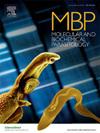Characterization and immunogenicity analysis of glutathi- one S-transferase from Otodectes cynotis
IF 1.4
4区 医学
Q4 BIOCHEMISTRY & MOLECULAR BIOLOGY
引用次数: 0
Abstract
Otodectes cynotis (ear mite), the primary etiological agent of feline otitis externa, represents a significant veterinary concern due to its high prevalence and treatment challenges. Glutathione S-transferase (GST), a detoxifying and immunogenic enzyme in various parasites, is a potential molecular target for vaccine development. In this study, we cloned and heterologously expressed the GST gene from O. cynotis, confirmed its recombinant protein activity using 1-chloro-2,4-dinitrobenzene (CDNB) as a substrate, and determined its optimal enzymatic conditions (pH 8, 30 °C). Bioinformatic analysis revealed high sequence conservation with arthropod homologs, predicted functional domains, and identified several immunogenic B- and T-cell epitopes. Molecular docking with ethacrynic acid indicated stable binding, suggesting GST as a potential drug target. This study presents the first functional and immunogenic characterization of O. cynotis GST, suggesting its critical role in oxidative stress mitigation and drug detoxification, and supporting its potential as an anti-mite vaccine candidate.
耳细胞囊炎谷胱甘肽- 1 s -转移酶的特性及免疫原性分析。
耳螨是猫外耳炎的主要病原,由于其高患病率和治疗挑战,引起了兽医的重大关注。谷胱甘肽s -转移酶(GST)是多种寄生虫的解毒和免疫原性酶,是开发疫苗的潜在分子靶点。在本研究中,我们克隆并异源表达了O. cynotis的GST基因,以1-氯-2,4-二硝基苯(CDNB)为底物证实了其重组蛋白的活性,并确定了其最佳酶促条件(pH 8, 30°C)。生物信息学分析揭示了节肢动物同源物的高序列保守性,预测了功能域,并鉴定了几个免疫原性B和t细胞表位。与乙酸分子对接,结合稳定,提示GST是潜在的药物靶点。本研究首次提出了cynotis GST的功能和免疫原性特征,表明其在氧化应激缓解和药物解毒中起关键作用,并支持其作为抗螨候选疫苗的潜力。
本文章由计算机程序翻译,如有差异,请以英文原文为准。
求助全文
约1分钟内获得全文
求助全文
来源期刊
CiteScore
2.90
自引率
0.00%
发文量
51
审稿时长
63 days
期刊介绍:
The journal provides a medium for rapid publication of investigations of the molecular biology and biochemistry of parasitic protozoa and helminths and their interactions with both the definitive and intermediate host. The main subject areas covered are:
• the structure, biosynthesis, degradation, properties and function of DNA, RNA, proteins, lipids, carbohydrates and small molecular-weight substances
• intermediary metabolism and bioenergetics
• drug target characterization and the mode of action of antiparasitic drugs
• molecular and biochemical aspects of membrane structure and function
• host-parasite relationships that focus on the parasite, particularly as related to specific parasite molecules.
• analysis of genes and genome structure, function and expression
• analysis of variation in parasite populations relevant to genetic exchange, pathogenesis, drug and vaccine target characterization, and drug resistance.
• parasite protein trafficking, organelle biogenesis, and cellular structure especially with reference to the roles of specific molecules
• parasite programmed cell death, development, and cell division at the molecular level.

 求助内容:
求助内容: 应助结果提醒方式:
应助结果提醒方式:


